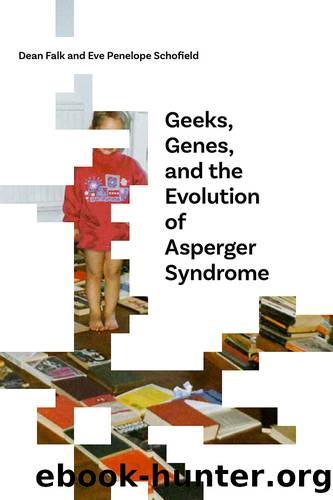Geeks, Genes, and the Evolution of Asperger Syndrome (9780826356932) by Falk Dean; Schofield Eve Penelope

Author:Falk, Dean; Schofield, Eve Penelope
Language: eng
Format: epub
Publisher: Lightning Source Inc
Published: 2018-11-15T00:00:00+00:00
How Prevalent Is Asperger Syndrome?
To return to a question raised earlier, how does the prevalence of AS stack up against other kinds of autism and does it occur globally? Although there is not much information that specifically addresses this question, there is some, and it is very interesting. Psychiatrist Eric Fombonne of Montreal Childrenâs Hospital in Canada conducted one of the first studies that compared the prevalence of AS with that of all other forms of autism combined. Fombonneâs analysis included ten surveys that were published between 1998 and 2007, six in the United Kingdom and one each in Norway, Sweden, Denmark, and Canada. Although diagnostic criteria for AS differed somewhat among the studies,15 its prevalence was lower than that for autism in nine of the ten surveys. Fombonne estimated that, on average, for every case of AS there were three or four cases of autism in these countries.16
A more recent study of eighteen surveys (from 1998 through 2012) from the above countries plus Australia, Finland, Venezuela, and the Netherlands calculated that estimates for the prevalence of AS averaged 0.12 percent, or slightly over one-tenth of 1 percent of the population, although the estimates varied widely.17 Again, the rates for AS in this recent study were consistently lower than those for Autistic Disorder, with an average of around one person with AS for every six with Autistic Disorder. (Autistic Disorder, which was defined in DSM-IV as distinct from Aspergerâs Disorder, would today be included in ASD.) Still other studies have estimated a higher prevalence of AS that is over one half of 1 percent of the population.18 Some have cautioned, however, that prevalence estimates for AS may have been inflated by inclusion of individuals with high-functioning autism, and that the diagnostic criteria and measurement techniques for distinguishing AS from Autistic Disorder have been inconsistent, leading them to conclude that the âdata on AS are therefore of dubious quality.â19
But all is not lost. One of the best windows into the relative prevalence of AS, at least in the United States, comes from a CDC surveillance of 363,749 eight-year-old children in 2010 from eleven sites in different American states.20 One in 68 of the children (about 1.5 percent) were diagnosed with autism. Of these, 3,822 children received diagnoses for a specific subtype of autism, including AS diagnosed with DSM-IV criteria. The percentage of children identified as Aspies ranged from 7 to 17 percent of those diagnosed with any form of autism across the various sites, with an average of 11 percent. This translates to a ratio of approximately one individual with AS for every eight with non-AS diagnoses of autism (that is, one of nine).21 Although CDC surveillances began incorporating DSM-5 diagnostic criteria for ASD in 2014, they will continue to evaluate children with the DSM-IV criteria for autism as well. In other words, despite the elimination of Aspergerâs Disorder from DSM-5, future analyses by the CDC should shed light on the extent to which the ârealâ prevalence of AS is increasing in the United States.
Download
This site does not store any files on its server. We only index and link to content provided by other sites. Please contact the content providers to delete copyright contents if any and email us, we'll remove relevant links or contents immediately.
I Capture the Castle by Dodie Smith(1905)
Aspergirls by Rudy Simone(1585)
Be Different by John Elder Robison(1558)
Autism's False Prophets by Paul A. Offit(1450)
My Child's Different by Elaine Halligan(1428)
Smart but Scattered—and Stalled by Richard Guare(1414)
101 Tips for the Parents of Boys with Autism by Ken Siri(1382)
What's Making Our Children Sick? by Michelle Perro(1350)
Asperger Syndrome (Autism Spectrum Disorder) and Long-Term Relationships by Ashley Stanford(1331)
ADHD by Mark Selikowitz(1304)
Girlish by Lara Lillibridge(1294)
Nerdy, Shy, and Socially Inappropriate by Cynthia Kim(1272)
An Adult with an Autism Diagnosis by Gillan Drew(1265)
On Immunity: An Inoculation by Biss Eula(1245)
Animal-assisted Interventions for Individuals with Autism by Temple Grandin(1223)
Sarah's Child (Hqn Romance) by Linda Howard(1221)
Seeing Ezra by Kerry Cohen(1199)
Why Gender Matters by Leonard Sax M.D. Ph.D(1184)
The Cities by K.A Knight(1178)
